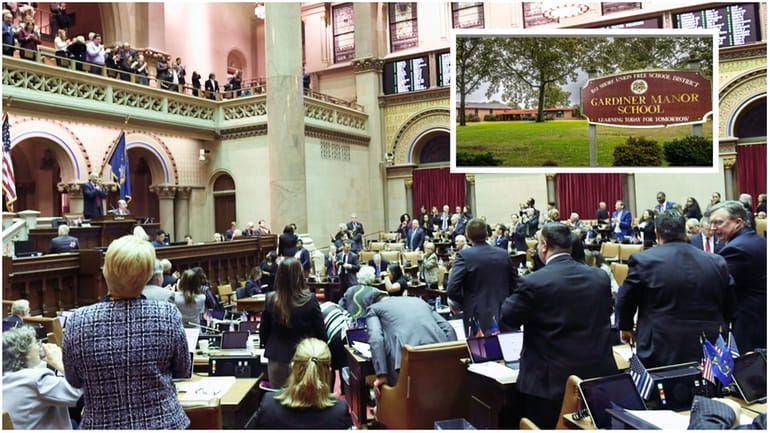Paying the costs of sexual abuse

Assembly members applaud after passing the Child Victims Act in January 2019. Inset: The Gardiner Manor elementary school in the Bay Shore school district, which faces the largest number of sexual abuse lawsuits of any school district on Long Island. Credit: AP / Hans Pennink, Newsday / J. Conrad Williams Jr.
The allegations of child sexual abuse against former Bay Shore teacher Thomas Bernagozzi are enormous. So are the potential costs for that school district, which will be on the hook for any civil damages his victims may win in the 45 cases filed under the state Child Victims Act.
The legislation enacted in 2019 created a legal window to allow anyone who was abused years ago when they were children to file for compensation. Bay Shore faces more lawsuits under this act than any Long Island school district. The window for filing these lawsuits closed in 2021.
Unsurprisingly, that extraordinary change in the law had consequences that only now are being quantified. It allowed lawsuits that otherwise would have been barred because of time limits to be filed against schools, nonprofit organizations and religious groups like the Roman Catholic Diocese of Rockville Centre, which recently filed for bankruptcy because of the huge penalties it faces for child sexual abuse by former clergy members.
Recognizing the fiscal devastation likely to be caused by these payouts, the State Legislature is considering a bill that would provide $200 million in a special fund to bail out government entities facing this problem. It would partially reimburse damages — not covered by insurance — that juries and judges award to schools and state-contracted foster care agencies that are found negligent. It is designed to relieve the crushing financial impact from victim compensation on individual districts where wrongdoing took place and instead spread the fiscal burden among all of the state’s taxpayers.
POORLY CONCEIVED FUND
Undoubtedly, those who suffered proven sexual abuse should be properly compensated, to the extent any money can be a salve for the terrible emotional and physical toll from abuse. But this proposed $200 million fund and its financial impact on taxpayers seem poorly thought out, similar to the way the backers of the 2019 Child Victims Act failed to consider the full financial impact of that legislation.
Overall, finding the right balance between survivors’ demands for justice and future finances of organizations affected is essential. “Nobody wants to see a diocese or the Catholic Church bankrupt, so how it is done is very important,” said then-Gov. Andrew M. Cuomo in 2018, while the original act was being debated. But that’s exactly what happened in Rockville Centre and with other groups providing educational, social, health, religious and community services for the young.
One of the problems of a $200 million fund is that we still don’t know how much liability taxpayers will face from Child Victims Act lawsuits. On Long Island alone, 27 school districts so far have settled 42 lawsuits for a combined $31.6 million. But there are 150 more lawsuits ongoing — including more than a dozen involving the same employee in Herricks, which already settled four cases involving that employee but was found not negligent by a jury Friday in a fifth claim. If those 150 lawsuits also settled at the previous payout rate, the Long Island bill for those 150 lawsuits would total $112 million — more than half the proposed $200 million pot. And this doesn’t include the many other abuse lawsuits which have been filed in New York City and the rest of the state that would be eligible for such a special fund.
Another flaw in the bill for the $200 million fund is the lack of accountability for individual school districts that ignored clear warning signals of child sexual abuse by their employees, making them liable. In the Bernagozzi case, Bay Shore district officials knew of at least five alleged incidents in 30 years of teaching, but they never moved to fire him or alert police. The staggering compensation to the victims will be a stinging reminder that along with the venerated claim of local control of schools comes the responsibility to make sure they are run safely and protect children from predators.
WHOSE RESPONSIBILITY?
The alternative being proposed is that all of New York will be responsible for the cost of the failure by school district administrators. Does not having to face the consequences of their failure erode the need for individual responsibility by school officials and oversight by taxpayers who vote every year to choose board members who oversee governance of the district?
This proposed bill also would help groups that don’t have adequate insurance coverage to pay for these court-awarded damages. Voluntary foster agencies reportedly face almost 900 CVA claims, with almost half having no insurance.
However, if state lawmakers and Gov. Kathy Hochul proceed with this idea of a $200 million special fund, they should provide an oversight mechanism similar to the 9/11 Victim Compensation Fund, to ensure fairness across New York State. Such an approach would take these lawsuits out of the court system and into the purview of an independent compensation board that could find a fair resolution for individual payouts and make them comparably uniform around the state while also reducing the amount of money paid to lawyers. Lawmakers should insist that school districts and other groups that failed to adequately protect children from abuse pay back over time the amount of money dispensed by the state special fund on their behalf.
Society ignored the problem of child sexual abuse for too long, but we must make sure the restitution to victims is sensible and fair to all.
MEMBERS OF THE EDITORIAL BOARD are experienced journalists who offer reasoned opinions, based on facts, to encourage informed debate about the issues facing our community.
